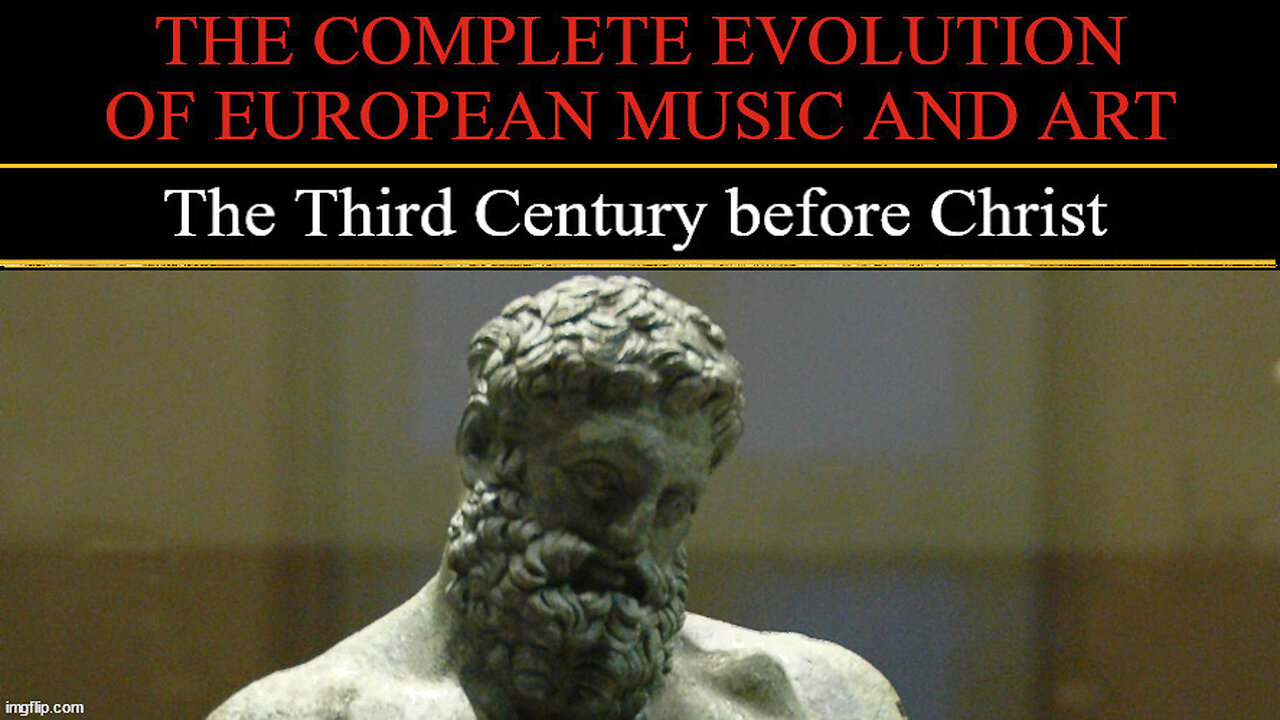Premium Only Content

Timeline of European Art and Music - The Third Century BC
Music Timestamps
0:00 - Circa 3rd Century BC - Ctesibius of Alexandria (Greek) - Hydraulus - Invented circa 3rd century BC. The world's first keyboard instrument and was the predecessor of the modern church organ.
1:31 - Circa 3rd Century BC - Ctesibius of Alexandria (Greek) - Hydraulus - The ancient hydraulis was played by hand, not automatically by the water-flow; the keys were balanced and could be played with a light touch, as is clear from the reference in a Latin poem by Claudian (late 4th century), who uses this very phrase (magna levi detrudens murmura tactu . . . intonet, “let him thunder forth as he presses out mighty roarings with a light touch”)
3:07 - Circa 3rd Century BC - Ctesibius of Alexandria (Greek) - Hydraulus - Operated by converting the dynamic energy of water into air pressure to drive the pipes. Required one person to contionouy press the pumps, and another to play the keys. On this particular hydraulus you can hear the operator starting the pumps before and after playing.
4:51 - Aulos or tibia (Latin) was an ancient Greek wind instrument that would have been popular during this time.
7:32 - Aulos - In myth, Marsyas the satyr was supposed to have invented the aulos, or else picked it up after Athena had thrown it away because it caused her cheeks to puff out and ruined her beauty.
9:39 - Aulos - Marsyas the satyr challenged Apollo to a musical contest, where the winner would be able to "do whatever he wanted" to the loser—Marsyas's expectation, typical of a satyr, was that this would be sexual in nature. But Apollo and his lyre beat Marsyas and his aulos. And since the pure lord of Delphi's mind worked in different ways from Marsyas's, he celebrated his victory by stringing his opponent up from a tree and flaying him alive.
-
 LIVE
LIVE
MyronGainesX
17 hours ago $1.37 earnedLA Has Fallen! Protestors Takeover And Trump Sends More Troops!
2,419 watching -
 1:06:06
1:06:06
The Daily Signal
2 hours ago $0.59 earned🚨 BREAKING: Judge DENIES Newsom’s Emergency Motion to Block Trump
16.8K21 -
 11:11
11:11
MattMorseTV
5 hours ago $0.35 earnedNewsom's FUNDING just got EXPOSED.
6.93K48 -
 10:29
10:29
From The Desk Of Anthony Pompliano
3 hours ago $0.16 earnedAmerica’s Boldest Wealth Plan Yet — And It Starts at Birth
19.1K6 -
 LIVE
LIVE
PougleHall
1 hour agoGetting Tortured In Mario Kart - LIVE
127 watching -
 LIVE
LIVE
Wahzdee
3 hours ago🔥 Left Siege X – Splitgate 2 Just Hits Better!
69 watching -
 1:06:27
1:06:27
BonginoReport
4 hours agoBiden Spies With His Little Eye?! - Nightly Scroll w/ Hayley Caronia (Ep.66) - 06/10/2025
59.6K39 -
 LIVE
LIVE
RamrodJenkins
3 hours agoI forgot how fun this is! Feat. Little Ram!
24 watching -
 46:32
46:32
The Nick DiPaolo Show Channel
5 hours agoGov. Newsom Is a Shapeshifter | Nick Di Paolo Show #1749
58.9K65 -
 LIVE
LIVE
SlinderPigCamz
1 hour agoBen and ed a12cat34dog no rage quit challange
11 watching